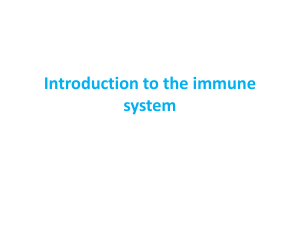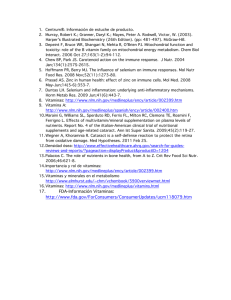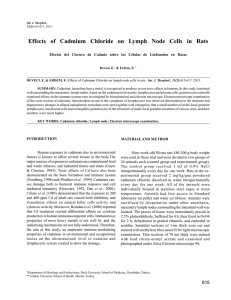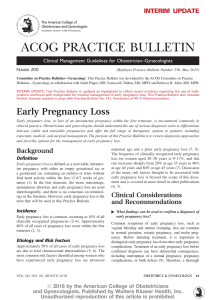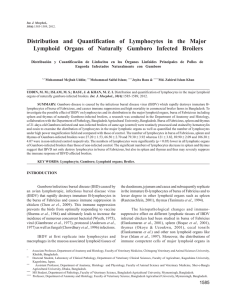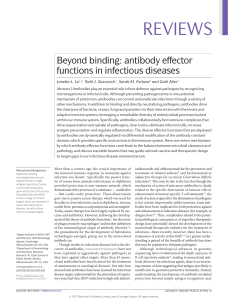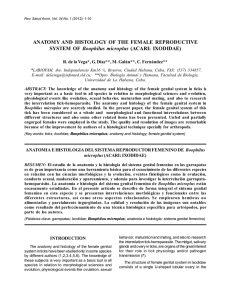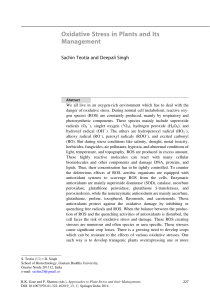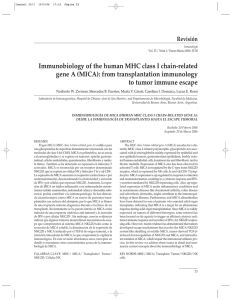maternal-foetal immunity: an admirable design in favour of life
Anuncio
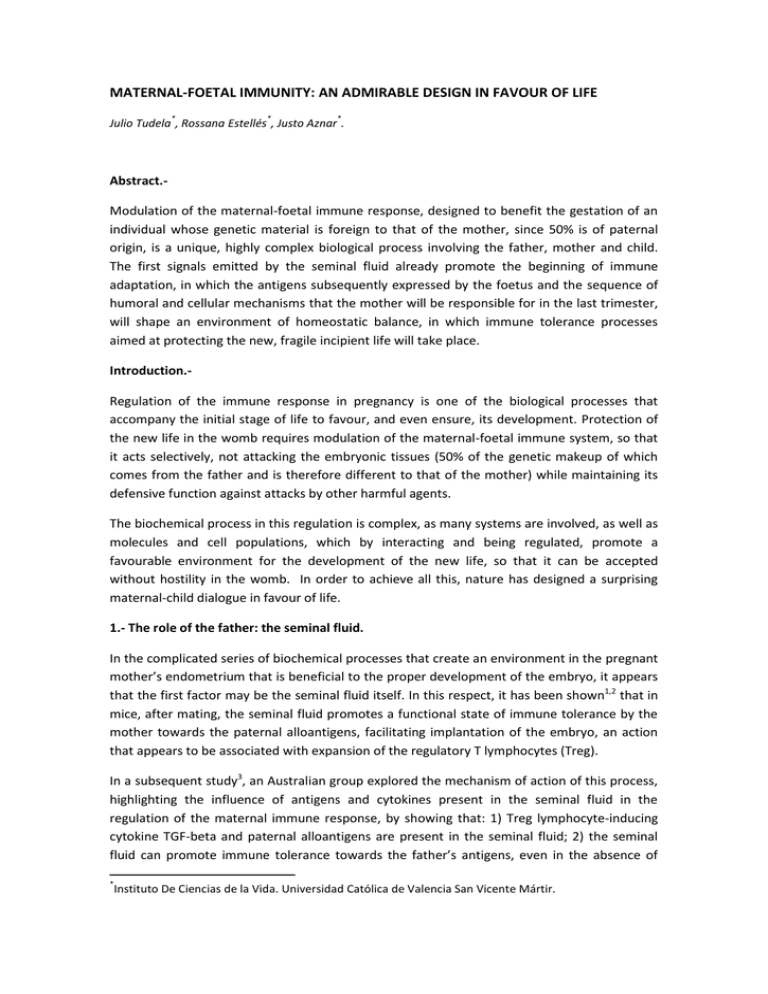
MATERNAL-FOETAL IMMUNITY: AN ADMIRABLE DESIGN IN FAVOUR OF LIFE * * * Julio Tudela , Rossana Estellés , Justo Aznar . Abstract.Modulation of the maternal-foetal immune response, designed to benefit the gestation of an individual whose genetic material is foreign to that of the mother, since 50% is of paternal origin, is a unique, highly complex biological process involving the father, mother and child. The first signals emitted by the seminal fluid already promote the beginning of immune adaptation, in which the antigens subsequently expressed by the foetus and the sequence of humoral and cellular mechanisms that the mother will be responsible for in the last trimester, will shape an environment of homeostatic balance, in which immune tolerance processes aimed at protecting the new, fragile incipient life will take place. Introduction.Regulation of the immune response in pregnancy is one of the biological processes that accompany the initial stage of life to favour, and even ensure, its development. Protection of the new life in the womb requires modulation of the maternal-foetal immune system, so that it acts selectively, not attacking the embryonic tissues (50% of the genetic makeup of which comes from the father and is therefore different to that of the mother) while maintaining its defensive function against attacks by other harmful agents. The biochemical process in this regulation is complex, as many systems are involved, as well as molecules and cell populations, which by interacting and being regulated, promote a favourable environment for the development of the new life, so that it can be accepted without hostility in the womb. In order to achieve all this, nature has designed a surprising maternal-child dialogue in favour of life. 1.- The role of the father: the seminal fluid. In the complicated series of biochemical processes that create an environment in the pregnant mother’s endometrium that is beneficial to the proper development of the embryo, it appears that the first factor may be the seminal fluid itself. In this respect, it has been shown1,2 that in mice, after mating, the seminal fluid promotes a functional state of immune tolerance by the mother towards the paternal alloantigens, facilitating implantation of the embryo, an action that appears to be associated with expansion of the regulatory T lymphocytes (Treg). In a subsequent study3, an Australian group explored the mechanism of action of this process, highlighting the influence of antigens and cytokines present in the seminal fluid in the regulation of the maternal immune response, by showing that: 1) Treg lymphocyte-inducing cytokine TGF-beta and paternal alloantigens are present in the seminal fluid; 2) the seminal fluid can promote immune tolerance towards the father’s antigens, even in the absence of * Instituto De Ciencias de la Vida. Universidad Católica de Valencia San Vicente Mártir. fertilisation and, therefore, of embryonic tissues; 3) the female dendritic cells (DCs) interact with the seminal fluid antigens to activate the CD8(+) and CD4(+) T lymphocytes; and finally 4) mating events deficient in either sperm or seminal fluid can cause diminished CD4(+), CD25(+) and FOXP3(+) Treg lymphocytes at the time of implantation. In a more recent article by the same group4, they extended their experiments to humans, showing that after coitus, the seminal fluid triggers an inflammatory response, mediated by cytokines and chemokines, which is accompanied by recruitment of macrophages, DCs and memory T lymphocytes. The leukocytes and cytokines that appear in the cervix, induced by the seminal fluid, appear to be responsible for the initiation of the adaptation in the female immune response, aimed at promoting fertility. 2.- The embryo and its influence on the immune response The embryo soon begins to defend its life against possible attacks. Far from being an inert tissue at the mercy of an environment (that of its mother), more sophisticated, it will begin to release interleukins that interact with specific receptors located in the Fallopian tubes, provoking a biochemical response5 which releases: a) growth factors that favour embryonic development; b) survival factors that exert an inhibitory effect on programmed cell death; c) LIF or leukaemia inhibitory factor, for which there are specific receptors on the embryonic trophoblast cells, making it possible for its cells to form part of the immune system in this stage of pregnancy6. Within this complex mechanism that regulates the mother’s immune response to the embryo that that is trying to implant itself, it appears that it is the histocompatibility antigen HLA-G7,8,9,10,11, expressed by the embryo in the blastocyst phase, which triggers this initial “biochemical dialogue” between mother and child, promoting the protection of its incipient and fragile human life, of unique and unrepeatable identity and therefore, different to that of its mother. The HLA-G antigen expression profile determines a specific response by the maternal T lymphocytes, which will defend it from cytotoxic mechanisms, such as the mother’s natural killer (NK) cells, which may put its normal development at risk. In fact, the HLA-G profile expressed by the embryo has a major role in the success of the implantation process. The adaptation of the Treg lymphocytes by the embryo against non-inherited maternal antigens (NIMAs) should also be highlighted, a fact that clearly illustrates the simultaneous adaptation of two genetically distinct organisms (mother and child) with a unique common end, the process of coexistence necessary for the development of the weakest12. 3.- The maternal response. The presence of the new individual in the womb of its mother is preceded by early biological adaptation of the woman. This adaptation anticipates the event of pregnancy, by causing objective changes at molecular and cellular level aimed at protecting a weak embryo that is beginning its life’s journey. The semen in the first place, and then the blastocyst itself, trigger a process to which the mother actively responds, limiting the humoral immune response to the implantation of her child. This causes attenuation of the cell response, mediated by the T Helper (Th) lymphocytes, and intensification of the activity of the Treg lymphocytes7. The former constitute the initial defence system against foreign elements or pathogenic microorganisms, while the second are responsible for preserving the integrity of the tissues themselves, by safeguarding them from the aggressive action of the immune response. In addition, the Th lymphocytes will be responsible for the balanced production of inflammatory (Th1) or anti-inflammatory cytokines (Th2), the balance of which is crucial in maintaining the pregnancy13. The Th1/Th2 ratio cell reaches its lowest level (predominantly Th2) in early pregnancy14, so that the foetal tissues are thus recognised and treated similarly to the mother’s own, a task assigned to the Treg lymphocytes (CD4(+), CD25(+), Foxp3(+)). Moreover, the NK cells, which play an important role in the response against infected or tumour cells, by promoting cell lysis and cytokine production, show greatly reduced activity at peripheral level, which favours progression of the pregnancy, since as we know, spontaneous abortions have been described when there is an increase in the activity of the aforementioned NK cells7, which regulate the invasion of the trophoblast in the decidua, myometrium and arteries of the uterus. In fact, it seems that in the first half of the pregnancy, the activated NK cells, which produce cytokines, synthesise some substances that promote the adaptation of the uterus to the requirements of the pregnancy, such as the angiogenic cytokine angiopoietin-2 and vascular endothelial growth factor15. The presence of uterine NK cells with defined characteristics that play a determining role in this adaptation process should also be mentioned. Like many other factors, hormones play an essential role in the regulation of maternal-foetal immune tolerance. It appears that, due to stimulation by the foetal antigens, pregnancy lymphocytes develop progesterone receptors which, in the presence of this hormone, produce a mediator molecule, PIBF (Progesterone Induced Blocking Factor); by altering the cytokine balance, PIBF inhibits NK activity, exerting an anti-abortive effect, as has been found in mice7. As well as the aforementioned cells, the immune response and its modulation during pregnancy also depend on the so-called antigen-presenting cells (APCs), which are responsible for the expression of signals in their membrane that will activate the T lymphocytes. These cells include macrophages, the epithelial cells of the vagina and cervix and the DCs. These APC cells are given a major role in the regulation of maternal-foetal immunity in the decidua of the endometrium, or the blastocyst implantation site16. They are involved in the creation of an environment that, on one side, will offer protection against infections, and on the other, will promote cell growth by inhibiting the inflammatory reactions by the immune system. The DCs will exert a role promoting immunity, or rather, immune tolerance, depending on their state of maturation, a circumstance that makes them biologically very plastic in their function. It appears that the most immature stages are associated with lower expression of the histocompatibility complexes and, therefore, decreased activation of the T lymphocytes, while the more mature forms are associated with activation of the Th1 lymphocytes, involved, as already noted, in the inflammatory response17. Moreover, the DCs present in the decidua will interact with the NK cells, constituting an additional factor regulating the immunity-tolerance balance. Again, hormones play a fundamental role in the establishment and development of the maternal-foetal tolerance balance: The macrophages are influenced by the level of oestrogens, which stimulate their activity, but progesterone is able to inhibit the capacity of the oestrogens to recruit macrophages which mediate the immune response, as trials in mice have shown18. The macrophages will analogously present two forms, defined as M1 and M2. The former are activated by the pro-inflammatory cytokines (Th1 lymphocytes), and secrete tumour necrosis factor (TNF) and interleukin (IL)-12, thus playing an important role in the development of inflammatory processes. However, the M2 macrophages, which have been influenced by the cytokines of the Th2 lymphocytes (IL-4, IL-10 and IL13) and glucocorticoids, will exert a protective, antiinflammatory function19. Their presence in the endometrial decidua during pregnancy appears to indicate that its immunosuppressive activity is important for the maintenance of immunological homeostasis20. Progesterone, as previously mentioned, will exert a modulatory role in immune tolerance processes, together with the oestrogens and chorionic gonadotrophin. It seems that these three are involved in the differentiation of the immature DCs, with a protective effect on the pregnancy, as has been seen. The first stimulates the Th2 lymphocyte response, reduces inflammatory cytokines and suppresses the allogenic responses, permitting survival of the foetus. Oestrogens and chorionic gonadotrophin appear to significantly reduce the ability of DCs to stimulate T lymphocytes21. In an in-vitro trial, it has also been shown that mature DCs produce less IL-18 when they are exposed to combinations of progesterone and chorionic gonadotrophin or oestradiol22. However, both the immature and mature DCs stimulate the secretion of IL-10, which has a protective effect in pregnancy. In view of the above, it seems that the high concentration reached by these hormones during pregnancy may be a determining factor in maternal-foetal immune tolerance mechanisms. Maternal-foetal immune tolerance memory.As we have seen, Treg lymphocytes (FOXP3+ CD4), specific for the foetus and immunosuppressive in nature, accumulate during the pregnancy. Some studies have related a reduction in the levels of these lymphocytes with complications in pregnancy, probably related with reactivation of the immune response of rejection of the embryo23,24,25. In a recent study26, it has been shown that the immune response that facilitates tolerance of the mother towards her child does not disappear after birth. The Treg lymphocytes persist at high levels, maintaining tolerance towards pre-existing foetal antigens, and accumulate rapidly when a new pregnancy begins. The accelerated expansion of the Treg during the second and subsequent pregnancies takes place almost exclusively at the cost of proliferation of FOXP3+ cells, specific for the foetus, conserved from the first pregnancy. The process of immune tolerance has an advantage as of the second pregnancy, in which the pregnant mother has already been “trained” to recognise the foreign foetal antigens and in the modulation of her immune response, so as to be conducive to progression of a new life. Rowe et el.26, in their study, stated that once it had been shown that these cells can generate and conserve immunological memory, this immune tolerance memory pathway could be used to design vaccines against autoimmune diseases such as juvenile idiopathic arthritis and type 1 diabetes, in which the immune system attacks its own healthy tissues. The immunological adaptation aimed at developing a new life seems to be the only biological process in which two different organisms participate with a single aim, directed at the survival of one of them. If we look at it in perspective, it is easy to see how complex mechanisms are activated and modulated, both immune and hormonal, which translates into the creation of a certain chemical environment that exclusively supports the development of one of the organisms involved. Many situations have been described today in which we can see how simple chemical changes regulate cell plasticity and the growth of certain cell populations with a specific function, but in this case we have a more complex process, in which the result is far from the tissue and humoral adaptations necessary for the correct functioning of the organism. Specifically, we have a process that is different from any metabolic adaptation, as it is the start and maintenance of a new living being. Conclusion.Although much progress has been made in the knowledge of the complicated processes that take place in the modulation of the immune response during pregnancy, little is known about the origin and regulation of the various inter-related systems. These are mutually balanced and admirably allow biochemical communication to be established between the father (through his seminal fluid), the child (who will express its HLA-G antigens) and the mother, who will trigger a cascade of adaptations that will give her immunity “intelligent activity”. This will allow her to be aggressive in defending herself against infectious or foreign agents while being tolerant towards the foetal antigens that will be identified as non-aggressive, and to which maternal immunity will develop a protective and growth promoting activity: a design of nature undoubtedly in favour of life. Alteration of this complex homeostasis will have negative consequences on the progression of the pregnancy, as already noted in part. In-vitro fertilisation can disrupt this equilibrium, by suppressing the phase of activation by the seminal fluid and the relationship of the blastocyst with its mother established in its journey through the Fallopian tubes, the pathway of the uterus. In an editorial in the prestigious journal Fertility and Sterility27, the data collected showed an increase in premature births, neonates with low birth weight and perinatal complications in children born after in-vitro fertilisation, compared to those conceived naturally. The alteration in the immune tolerance balance described could be one of the causes responsible for these facts. All of the above supports the important function of maternal immune tolerance towards the child to be implanted, which also highlights the teleological function of the biological mechanisms to facilitate the development of human life. References.1 Johansson M, Bromfield JJ, Jasper MJ, Robertson S. Semen activates the female immune response during early pregnancy in mice. Immunology 2004;112(2):290-11 2 Robertson s, et al. Seminal fluid drives expansion of the CD4+CD25+ T regulatory cell pool and induces tolerance to paternal alloantigen in mice. Biol. Reprod. 2009; 80(5):1036-45 3 Robertson S, et al. Activating T regulatory cells for tolerance in early pregnancy – the contribution of seminal fluid. J Reprod Immunol. 2009;83(1-2):109-16 4 Sharkey D, et al. Seminal fluids induces leukocyte recruitment and cytokine and chemokine mRNA expression in the human cervix after coitus. J Immunol. 2012;188(5):2445-54 5 Van Mourik MS, Macklon NS, Heijnen CJ. Embryonic implantation: cytokines, adhesion molecules, and immune cells in establishing an implantation environment. J Leukoc Biol. 2009;85(1):4–19. 6 López Moratalla N. Comunicación materno-filial en el embarazo. Cuad. Bioét. 2009;XX:303-13 7 Szekeres-Bartho J. Immunological relationship between the mother and the fetus. Int. Rev. Immunol. 2002;21(6):471-25 8 Rouas-Freiss N, et al. Direct evidence to support the role of HLA-G in protecting the fetus from maternal uterine natural killer cytolysis. Proc. Natl. Acad. Sci. USA. 1997;94:11520-6 9 Hunt JS, Petroff MG, McIntire RH, Ober C. HLA-G and immune tolerance in pregnancy. FASEB J. 2005;19(7):681-13. 10 Roussev RG, Coulam CB. HLA-G and its role in implantation (review). J Assist Reprod Genet. 2007;24(7):288-8. 11 Alegre E., Díaz-Lagares A., LeMaoult J., López-Moratalla N., Carosella E.D., González A. Maternal antigen presenting cells are a source of plasmatic HLA-G during pregnancy: Longitudinal study during pregnancy. Hum. Immunol. 2007;68:661-7. 12 Mold J, et al. Maternal Alloantigens Promote the Development of Tolerogenic Fetal Regulatory T Cells in Utero. Science. 2008;322(5907):1562–4. 13 Raghupathy R, et al. Cytokine production by maternal lymphocytes during normal human pregnancy and in unexplained recurrent spontaneous abortion. Hum Reprod. 2000;15:713-6 14 Saito S, et al. Distribution of Th1, Th2 and Th0 and the Th1/Th2 cell ratios in human peripheral and endometrial T cells. American Journal of Reproductive Immunology. 1999;42(4):240-6 15 Moffett A, Loke C. Immunology of placentation in eutherian mammals. Nature Reviews Immunology. 2006;6(8):584-11 16 Laskarin G, et al. Antigen-Presenting cells and materno-fetal tolerance: An emerging role for dendritic cells. Am J Reprod Immunol. 2007;58:255-13 17 Lutz M, Schuler G. Immature, semi-immature and fully mature dendritic cells: which signals induce tolerance or immunity? Trends in Immunol 2002;23:445-5 18 Tibbetts T, Conneely O, O´Malley B. Progesterone via its receptor antagonizes the pro-inflammatory activity of estrogen in the mouse uterus 19 Gordon S. Alternative activation of macrophages. Nature Reviews Immunology.2003;3(1):23-13 20 Shyi-Jou C, et al. Immunologic regulation in pregnancy: From mechanism to therapeutic strategy for immunomodulation. Clin Dev Immunol. 2012;2012:258391 21 Segerer S, et al. Impact of female sex hormones on the maturation and function of human dendritic cells. Am J Reprod Immunol. 2009;62(3):165-73 22 Huck B, et al. Pregnancy associated hormones modulate the cytokine production but not the phenotype of PBMC-derived human dendritic cells. Eur J Obstet Gynecol Reprod Biol. 2005;122(1)85-10 23 Prins, J. R. et al. Preeclampsia is associated with lower percentages of regulatory T cells in maternal blood. Hypertens. Pregnancy. 2009; 28:300–12. 24 Santner-Nanan, B. et al. Systemic increase in the ratio between Foxp3+ and IL-17-producing CD4+ T cells in healthy pregnancy but not in preeclampsia. J. Immunol. 2009;183:7023–8. 25 Sasaki, Y. et al. Decidual and peripheral blood CD4+CD25+ regulatory T cells in early pregnancy subjects and spontaneous abortion cases. Mol. Hum. Reprod. 2004;10: 347–7. 26 Rowe J, Ertelt J, Xin L, Way S. Pregnancy imprints regulatory memory that sustains anergy to fetal antigen. Nature. 2012;490:102-5 27 Fertility and Sterility.2011;95:1187-3
